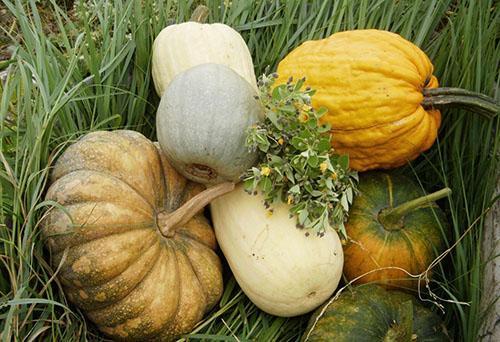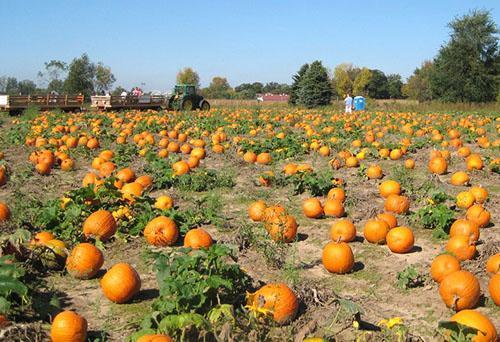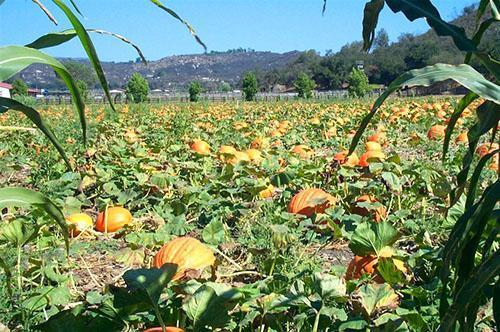It is useful to know how and when pumpkin of different ripeness is harvested
 Autumn is the time for summing up the results of spring-summer work and harvesting. Pumpkin, as an unpretentious and rather cold-resistant culture, is one of the last to be sent for storage. But when is it more correct to do this? Since at the disposal of gardeners today there are more than a dozen varieties of pumpkin with different characteristics and ripening periods, the time of harvesting vegetables largely depends on their early maturity, as well as on the weather and climatic characteristics of the region. When to remove the earliest varieties from the garden, and how long do late-ripening fruits stay in the garden?
Autumn is the time for summing up the results of spring-summer work and harvesting. Pumpkin, as an unpretentious and rather cold-resistant culture, is one of the last to be sent for storage. But when is it more correct to do this? Since at the disposal of gardeners today there are more than a dozen varieties of pumpkin with different characteristics and ripening periods, the time of harvesting vegetables largely depends on their early maturity, as well as on the weather and climatic characteristics of the region. When to remove the earliest varieties from the garden, and how long do late-ripening fruits stay in the garden?
Ripening dates of different types of pumpkin

I begin to harvest such pumpkins in the second half of August, and in September, the hard fruits, even in cold summer, should be completely harvested. This type of fruit is not stored for a long time, if you overexpose the pumpkin and cut it after 5–6 months, germinated seeds and loose flesh that have lost quality will be found under the bark.
The moment when it is time to remove the pumpkin from the garden can be determined by the stiffness of the petiole, compaction, hardening of the bark and a change in its color.
 Mid-season varieties, which include most large-fruited pumpkins, which require time to gain weight and size, ripen in 110–130 days. Such fruits are tasty, their pulp is saturated vitamin A, is rich in trace elements and perfectly accumulates sugar. In addition, they are leaders in keeping quality, but long-term storage can be ensured only by cutting the pumpkin from the lash in time.
Mid-season varieties, which include most large-fruited pumpkins, which require time to gain weight and size, ripen in 110–130 days. Such fruits are tasty, their pulp is saturated vitamin A, is rich in trace elements and perfectly accumulates sugar. In addition, they are leaders in keeping quality, but long-term storage can be ensured only by cutting the pumpkin from the lash in time.
If the bark has not yet acquired the proper hardness or has been damaged by freezing, the pumpkin will have to be recycled.
Therefore, it is so important to remove pumpkins from the garden before the first cold weather, which in the Moscow region or in the Urals may begin in mid-September. If necessary, the fruits are left to ripen in a warm, dry room for 14–30 days before being sent for storage.
 The sweetest, fragrant pumpkins ripen later than all, to which the nutmeg varieties can also be attributed. It takes 130 to 150 days for the fruit to reach full maturity, therefore, like the large-fruited variety, these pumpkins are harvested before the frost season.
The sweetest, fragrant pumpkins ripen later than all, to which the nutmeg varieties can also be attributed. It takes 130 to 150 days for the fruit to reach full maturity, therefore, like the large-fruited variety, these pumpkins are harvested before the frost season.
Only in the south of the country, from the Rostov region to the Crimea, when late-ripening pumpkins are harvested, do they ripen on a whip. In other regions, they have to ripen from 1 to 2 months. At the same time, ripe fruits remain tasty and healthy for no longer than 4–5 months, so it is better to eat them without delay.
How do you know that the pumpkin is ripe, will be tasty and will endure several winter months without any problems?
Signs of pumpkin ripeness
 Regardless of the type and early maturity of the pumpkin, its fruits have common signs of ripening:
Regardless of the type and early maturity of the pumpkin, its fruits have common signs of ripening:
- First of all, the stalk of the pumpkin becomes hard, loses its juiciness and takes on the appearance of wood or cork.
- The bark of the pumpkin changes color in most varieties and varieties. The shades of green are replaced by yellow and orange tones, the pattern becomes clear.
- The bark becomes denser and difficult to damage with a fingernail.
- The scourge and foliage of the plant wither, turn yellow and die off.
If pumpkins with characteristic signs of ripening are removed from the garden, the fruits are well stored, their pulp does not lose moisture and taste for a long time.
It is better to pre-ripen incompletely ripe pumpkins until the fruit is completely protected from the external environment. But it is better not to store ovaries with unformed bark, but immediately process them into juice, homemade canned food or culinary dishes.
It is important to remember that not all varieties change color by autumn. A similar exception is waxy gourd, varieties with gray and white bark. The shade of butternut pumpkins changes slightly.
 When the pumpkin is removed for storage, these signs can be considered a selection criterion and a guarantee that the fruits will not dry out and rot.
When the pumpkin is removed for storage, these signs can be considered a selection criterion and a guarantee that the fruits will not dry out and rot.
How and when to remove pumpkin from the garden?
 The most delicious and healthy pulp is from pumpkins that are fully ripe in the garden and until the last day absorbed the sun's rays and nutrients from the soil. But climatic and weather conditions do not always allow this to be achieved. Therefore, when the pumpkin is already being harvested in the Urals, in the Stavropol Territory, the culture can remain in the beds for at least a month.
The most delicious and healthy pulp is from pumpkins that are fully ripe in the garden and until the last day absorbed the sun's rays and nutrients from the soil. But climatic and weather conditions do not always allow this to be achieved. Therefore, when the pumpkin is already being harvested in the Urals, in the Stavropol Territory, the culture can remain in the beds for at least a month.
The further north, the more often the gardeners on their garden beds it is necessary to plant early ripening varieties and to determine the timing of collection, use not the tips of the plant, but the forecast of meteorologists. For example, in the middle lane, pumpkins are removed from the lashes in mid-September, but in the southern regions they can be in the field until the lashes are completely dry.
At whatever time the harvest is taking place, it is important that the weather on the day the pumpkins are harvested is dry and warm enough. If the fruits lying on the ground fall under a severe frost, despite the dense bark, the vegetable suffers, and during storage it can rot.
The collection of fruits is carried out as carefully as possible, carefully treating each pumpkin. It is important not only to prevent cuts in the bark, but also to prevent the pumpkins from falling.
Indeed, even through microscopic cracks in the bark, microorganisms and bacteria easily penetrate, leading to the development of mold and rot inside the fruit. In addition, upon impact, the structure of the pulp changes, the juice begins to flow, which also leads to a rapid spoilage of the crop.
 When pumpkins are removed from the beds, it is better not to try to pluck or unscrew them from the lash, but to cut them off with a sharp knife, leaving a stalk 5 to 10 cm long.
When pumpkins are removed from the beds, it is better not to try to pluck or unscrew them from the lash, but to cut them off with a sharp knife, leaving a stalk 5 to 10 cm long.
If the pumpkin turns out to be without a "tail", it loses the natural protection of the pulp in the attachment area, which will inevitably be used by putrefactive bacteria and fungi. Therefore, when carrying and loading pumpkins, it is better not to take the handle, no matter how comfortable and strong it looks. This rule is especially important when growing full-bodied large-fruited pumpkins, juicy varieties intended for juice and sweet dessert varieties. Their damage will be the fastest.
After cutting from the whip, pumpkins are dried, carefully removing the remnants of soil and dry vegetation on the bark. Then the fruits for a period of 10 to 30 days are placed in existing covered storage, where the temperature reaches 27-29 ° C. With a moisture content of up to 85% in such conditions, pumpkins actively ripen, and their peel hardens.
 Upon learning that the pumpkins are ripe and ready for long-term storage, they select pure, whole fruits, without signs of mechanical damage and signs of disease.
Upon learning that the pumpkins are ripe and ready for long-term storage, they select pure, whole fruits, without signs of mechanical damage and signs of disease.
When selecting table pumpkins for the winter, their sizes are also taken into account. It is believed that pumpkins of at least 12-15 cm in diameter can withstand many months of stay in the basement.
 When putting pumpkins for storage, choose a dry, cool room, with a temperature of 10-13 ° C and constant ventilation. In the storage, the fruits are neatly laid out on racks or pallets, avoiding crowding and contact of the pumpkin with wet surfaces. It is best if:
When putting pumpkins for storage, choose a dry, cool room, with a temperature of 10-13 ° C and constant ventilation. In the storage, the fruits are neatly laid out on racks or pallets, avoiding crowding and contact of the pumpkin with wet surfaces. It is best if:
- the crop is placed in one layer above the ground level at least 10-15 cm;
- pumpkins do not touch or come into contact with other vegetables and fruits;
- the store is protected from rodents;
- there is no condensation and fungal infection in the room.
It is especially important not to place the pumpkin in the immediate vicinity of apples, pears, quince. These fruits release ethylene, which accelerates fruit ripening and shortens the shelf life of the pumpkin. In the winter months, while the crop is not used for food, it is periodically revised to discard damaged or softened fruits.